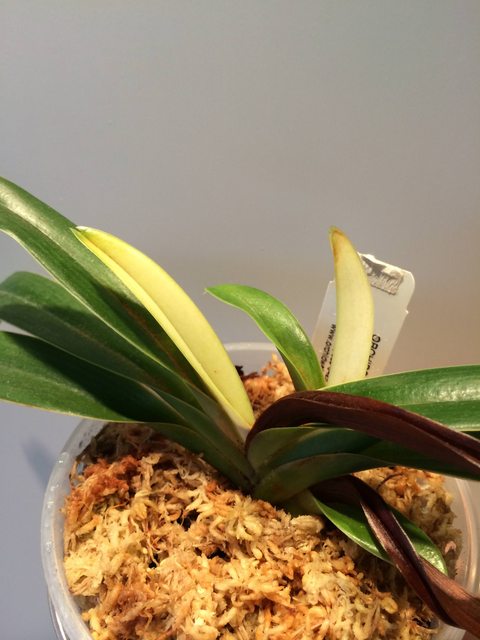Happypaphy7
Paphlover
Last year, I posted Paphiopedilum Pink Sky with bleaching leaves.
I have three Pink Sky and the other two are fine under the same conditions.
After I moved it out of the artificial light, it immediately started to return green and now the plant is completely green after a few months with some very small patches of white area here and there.
http://www.slippertalk.com/forum/showthread.php?t=41906&highlight=bleaching
Now, I am posting a new plant with a similar issue.
The plant is Paphiopedilum Dolliroth, a primary between henryanum and rothschildianum.
Someone posted a beautiful example of this hybrid in the past. The plant was purchased from Orchid Limited.
I looked up and they had very limited stock, so I got one in December 2016.
It has been a terribly slow grower working on second leaf since its arrival.
I have grown this under T8 like many of my other plants.
The first new leaf under my care came out near cream white, which then turned brown and now completely dead shown in the picture.
The second leaf is coming out completely cream white also.
There are two growths, and both are doing the exact same thing.
If it wasn't so rare, I would have just tossed it.
I would love to see it flower one day! It is a small plant in 2inch pot (now repotted in 4 inch pot in the photo), and supposedly a blooming size or near blooming size.
I wonder what in the artificial light might cause this on some plants and not on most others?
I moved the plant out of the artificial light two weeks ago. Still white as the phot was just taken today after watering.

I have three Pink Sky and the other two are fine under the same conditions.
After I moved it out of the artificial light, it immediately started to return green and now the plant is completely green after a few months with some very small patches of white area here and there.
http://www.slippertalk.com/forum/showthread.php?t=41906&highlight=bleaching
Now, I am posting a new plant with a similar issue.
The plant is Paphiopedilum Dolliroth, a primary between henryanum and rothschildianum.
Someone posted a beautiful example of this hybrid in the past. The plant was purchased from Orchid Limited.
I looked up and they had very limited stock, so I got one in December 2016.
It has been a terribly slow grower working on second leaf since its arrival.
I have grown this under T8 like many of my other plants.
The first new leaf under my care came out near cream white, which then turned brown and now completely dead shown in the picture.
The second leaf is coming out completely cream white also.
There are two growths, and both are doing the exact same thing.
If it wasn't so rare, I would have just tossed it.
I would love to see it flower one day! It is a small plant in 2inch pot (now repotted in 4 inch pot in the photo), and supposedly a blooming size or near blooming size.
I wonder what in the artificial light might cause this on some plants and not on most others?
I moved the plant out of the artificial light two weeks ago. Still white as the phot was just taken today after watering.












































